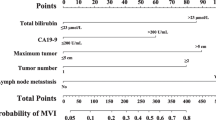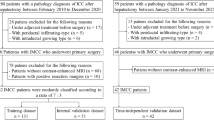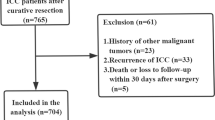Abstract
Background
Microvascular invasion (MVI) has been reported to be an independent prognostic factor of recurrence and poor overall survival in patients with intrahepatic cholangiocarcinoma (ICC). This study aimed to explore the preoperative independent risk factors of MVI and establish a Bayesian network (BN) prediction model to provide a reference for surgical diagnosis and treatment.
Methods
A total of 531 patients with ICC who underwent radical resection between 2010 and 2018 were used to establish and validate a BN model for MVI. The BN model was established based on the preoperative independent variables. The ROC curves and confusion matrix were used to assess the performance of the model.
Results
MVI was an independent risk factor for relapse-free survival (RFS) (P < 0.05). MVI has a correlation with postoperative recurrence, early recurrence (< 6 months), median RFS and median overall survival (all P < 0.05). The preoperative independent risk variables of MVI included obstructive jaundice, prognostic nutritional index, CA19-9, tumor size, and major vascular invasion, which were used to establish the BN model. The AUC of the BN model was 78.92% and 83.01%, and the accuracy was 70.85% and 77.06% in the training set and testing set, respectively.
Conclusion
The BN model established based on five independent risk variables for MVI is an effective and practical model for predicting MVI in patients with ICC.



Similar content being viewed by others
References
Massarweh NN, El-Serag HB (2017) Epidemiology of hepatocellular carcinoma and intrahepatic cholangiocarcinoma. Cancer Control 24:1145164509
Sirica AE, Gores GJ, Groopman JD, Selaru FM, Strazzabosco M, Wei WX, Zhu AX (2019) Intrahepatic cholangiocarcinoma: continuing challenges and translational advances. Hepatology 69:1803–1815
Ferlay J, Colombet M, Soerjomataram I, Dyba T, Randi G, Bettio M, Gavin A, Visser O, Bray F (2018) Cancer incidence and mortality patterns in Europe: estimates for 40 countries and 25 major cancers in 2018. Eur J Cancer 103:356–387
Jutric Z, Johnston WC, Hoen HM, Newell PH, Cassera MA, Hammill CW, Wolf RF, Hansen PD (2016) Impact of lymph node status in patients with intrahepatic cholangiocarcinoma treated by major hepatectomy: a review of the national cancer database. HPB (Oxford) 18:79–87
Spolverato G, Kim Y, Alexandrescu S, Marques HP, Lamelas J, Aldrighetti L, Clark GT, Maithel SK, Pulitano C, Bauer TW, Shen F, Poultsides GA, Tran TB, Wallis MJ, Pawlik TM (2016) Management and outcomes of patients with recurrent intrahepatic cholangiocarcinoma following previous curative-intent surgical resection. Ann Surg Oncol 23:235–243
Tang Z, Liu WR, Zhou PY, Ding ZB, Jiang XF, Wang H, Tian MX, Tao CY, Fang Y, Qu WF, Dai Z, Qiu SJ, Zhou J, Fan J, Shi YH (2019) Prognostic value and predication model of microvascular invasion in patients with intrahepatic cholangiocarcinoma. J Cancer 10:5575–5584
Shao C, Chen J, Chen J, Shi J, Huang L, Qiu Y (2017) Histological classification of microvascular invasion to predict prognosis in intrahepatic cholangiocarcinoma. Int J Clin Exp Pathol 10:7674–7681
Wang T, Yang X, Tang H, Kong J, Shen S, Qiu H, Wang W (2020) Integrated nomograms to predict overall survival and recurrence-free survival in patients with combined hepatocellular cholangiocarcinoma (cHCC) after liver resection. Aging (Albany NY) 12:15334–15358
Lu WF, Chen PQ, Yan K, Wu YC, Liang L, Yuan JY, Fu Y, Zhang HB (2021) Synergistic impact of resection margin and microscopic vascular invasion for patients with HBV-related intrahepatic cholangiocarcinoma. Expert Rev Gastroenterol Hepatol 15:575–582
Hirokawa F, Hayashi M, Miyamoto Y, Asakuma M, Shimizu T, Komeda K, Inoue Y, Uchiyama K (2014) Outcomes and predictors of microvascular invasion of solitary hepatocellular carcinoma. Hepatol Res 44:846–853
Lei Z, Li J, Wu D, Xia Y, Wang Q, Si A, Wang K, Wan X, Lau WY, Wu M, Shen F (2016) Nomogram for preoperative estimation of microvascular invasion risk in Hepatitis B virus-related hepatocellular carcinoma within the Milan criteria. JAMA Surg 151:356–363
Zhou Y, Wang X, Xu C, Zhou G, Liu X, Gao S, Xu P (2019) Mass-forming intrahepatic cholangiocarcinoma: can diffusion-weighted imaging predict microvascular invasion? J Magn Reson Imaging 50:315–324
Zhou Y, Zhou G, Zhang J, Xu C, Wang X, Xu P (2021) Radiomics signature on dynamic contrast-enhanced MR images: a potential imaging biomarker for prediction of microvascular invasion in mass-forming intrahepatic cholangiocarcinoma. Eur Radiol 31:6846–6855
Ma X, Liu L, Fang J, Rao S, Lv L, Zeng M, Shi Y, Yang C (2020) MRI features predict microvascular invasion in intrahepatic cholangiocarcinoma. Cancer Imaging 20:40
Tsilimigras DI, Hyer JM, Moris D, Sahara K, Bagante F, Guglielmi A, Aldrighetti L, Alexandrescu S, Marques HP, Shen F, Koerkamp BG, Endo I, Pawlik TM (2019) Prognostic utility of albumin-bilirubin grade for short- and long-term outcomes following hepatic resection for intrahepatic cholangiocarcinoma: a multi-institutional analysis of 706 patients. J Surg Oncol 120:206–213
Kanda M, Fujii T, Kodera Y, Nagai S, Takeda S, Nakao A (2011) Nutritional predictors of postoperative outcome in pancreatic cancer. Br J Surg 98:268–274
Wang J, Bo X, Li M, Nan L, Wang C, Gao Z, Suo T, Ni X, Liu H, Han J, Lu P, Liu H, Wang Y (2021) Prediction efficacy for clinical outcome of prognostic nutritional index in patients with resectable biliary tract cancer depends on sex and obstructive jaundice status. Ann Surg Oncol 28:430–438
Brada L, Daamen LA, Magermans LG, Walma MS, Latifi D, van Dam RM, de Hingh IH, Liem M, de Meijer VE, Patijn GA, Festen S, Stommel M, Bosscha K, Polée MB, Nio YC, Wessels FJ, de Vries J, van Lienden KP, Bruijnen RC, Busch OR, Koerkamp BG, van Eijck C, Molenaar QI, Wilmink H, van Santvoort HC, Besselink MG (2021) Survival benefit associated with resection of locally advanced pancreatic cancer after upfront FOLFIRINOX versus FOLFIRINOX only: multicenter propensity score-matched analysis. Ann Surg 274:729–735
Wu Y, Li Q, Cai Z, Zhang Y, Qiu Y, Yang N, Song T, Li S, Lou J, Li J, Mao X, Chen C, Zhang D, Si S, Geng Z, Tang Z (2020) Survival prediction for gallbladder carcinoma after curative resection: comparison of nomogram and Bayesian network models. Eur J Surg Oncol 46:2106–2113
Cong LL, Cai ZQ, Guo P, Chen C, Liu DC, Li WZ, Wang L, Zhao Y, Si SB, Geng ZM (2017) Decision of surgical approach for advanced gallbladder adenocarcinoma based on a Bayesian network. J Surg Oncol 116:1123–1131
Park JC, Lee JY (2018) How to build nomogram for type 2 diabetes using a nave Bayesian classifier technique. J Appl Stat 45:2999–3011
Morrison DG (1969) On the interpretation of discriminant analysis. J Mark Res 6:156–163
Lee YT, Wang JJ, Luu M, Noureddin M, Nissen NN, Patel TC, Roberts LR, Singal AG, Gores GJ, Yang JD (2021) Comparison of clinical features and outcomes between intrahepatic cholangiocarcinoma and hepatocellular carcinoma in the United States. Hepatology 74:2622–2632
Wang Y, Li J, Xia Y, Gong R, Wang K, Yan Z, Wan X, Liu G, Wu D, Shi L, Lau W, Wu M, Shen F (2013) Prognostic nomogram for intrahepatic cholangiocarcinoma after partial hepatectomy. J Clin Oncol 31:1188–1195
Zhang Z, Zhou Y, Hu K, Wang D, Wang Z, Huang Y (2020) Perineural invasion as a prognostic factor for intrahepatic cholangiocarcinoma after curative resection and a potential indication for postoperative chemotherapy: a retrospective cohort study. BMC Cancer 20:270
Akgül Ö, Bagante F, Olsen G, Cloyd JM, Weiss M, Merath K, Alexandrescu S, Marques HP, Aldrighetti L, Maithel SK, Pulitano C, Bauer TW, Shen F, Poultsides GA, Soubrane O, Martel G, Koerkamp BG, Guglielmi A, Itaru E, Pawlik TM (2018) Preoperative prognostic nutritional index predicts survival of patients with intrahepatic cholangiocarcinoma after curative resection. J Surg Oncol 118:422–430
Roayaie S, Blume IN, Thung SN, Guido M, Fiel MI, Hiotis S, Labow DM, Llovet JM, Schwartz ME (2009) A system of classifying microvascular invasion to predict outcome after resection in patients with hepatocellular carcinoma. Gastroenterology 137:850–855
Cheng Z, Lei Z, Jin X, Zhang Q, Si A, Yang P, Zhou J, Hartmann D, Hüser N, Shen F (2021) Postoperative adjuvant transarterial chemoembolization for intrahepatic cholangiocarcinoma patients with microvascular invasion: a propensity score analysis. J Gastrointest Oncol 12:819–830
Wang X, Wang W, Ma X, Lu X, Li S, Zeng M, Xu K, Yang C (2020) Combined hepatocellular-cholangiocarcinoma: which preoperative clinical data and conventional MRI characteristics have value for the prediction of microvascular invasion and clinical significance? Eur Radiol 30:5337–5347
Funding
This study was supported by the National Natural Science Foundation of China (No. 62076194, No. 81772521); Multicenter Clinical Research Project of Shanghai Jiaotong University, School of Medicine (DLY201807); Clinical Training Program of Shanghai Xinhua Hospital Affiliated to Shanghai Jiaotong University, School of Medicine (17CSK06).
Author information
Authors and Affiliations
Contributions
ZG and ZT conceived and designed the experiments. Q L and JZ performed the experiments. HW, YQ, TS, XM, YH, ZC, WZ, and JL collected and offered the data. QL and JZ contributed analysis tools. QL, JZ, ZC, CC, SS and DZ conducted statistical analysis. QL and JZ wrote the paper. ZG and ZT reviewed the manuscript. All authors read and approved the final manuscript.
Corresponding authors
Ethics declarations
Conflict of interest
The authors have no conflict of interest to declare.
Additional information
Publisher's Note
Springer Nature remains neutral with regard to jurisdictional claims in published maps and institutional affiliations.
Supplementary Information
Below is the link to the electronic supplementary material.
Rights and permissions
Springer Nature or its licensor (e.g. a society or other partner) holds exclusive rights to this article under a publishing agreement with the author(s) or other rightsholder(s); author self-archiving of the accepted manuscript version of this article is solely governed by the terms of such publishing agreement and applicable law.
About this article
Cite this article
Li, Q., Zhang, J., Cai, Z. et al. A Bayesian Network Prediction Model for Microvascular Invasion in Patients with Intrahepatic Cholangiocarcinoma: A Multi-institutional Study. World J Surg 47, 773–784 (2023). https://doi.org/10.1007/s00268-022-06867-5
Accepted:
Published:
Issue Date:
DOI: https://doi.org/10.1007/s00268-022-06867-5




